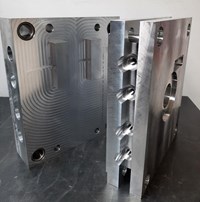How to Automate Process and Design in Moldmaking
Mold builders can achieve major operational improvements by automating their digital workflows, particularly in CAD/CAM design, programming and process planning.

Done right, automation helps you do more with less — increasing your shop’s output, improving consistency and making it an attractive place for the next generation of manufacturers.
Source | Tebis
Moldmakers face more complexity than ever before — rising costs, global competition, tariff implications and persistent workforce shortages demand greater efficiency at every level. To stay competitive, mold shops must move beyond traditional practices and embrace process and design automation as a strategic advantage.
So here is my question – how are your company’s continuous improvement efforts going? Specifically, how is your company improving process, technology and people as it transitions to manufacturing automation?
Often, when manufacturers think of automation, they envision robots, cobots or vision systems on the shop floor. While these technologies have their place, moldmakers can drive significant operational gains by focusing on automating the digital side, especially CAD/CAM design, programming and process planning.
Think of automation as a marathon, not a sprint. It demands investment, training and a mindset shift — but with the right steps, even small-to-medium-sized shops can see powerful returns.
How is your company’s continuous improvement efforts going? Specifically, how is your company improving process, technology and people as it transitions to manufacturing automation?
Here are six easy steps that you can apply to your operation:
1. Assess and Prepare Your Business
Before you can automate, evaluate whether your infrastructure and team are ready. Just like training for a marathon, you need a baseline of health and capability.
Ask yourself:
- Are your machines modern and compatible with automation technologies?
- Does your current software support parametric design and automation workflows?
- Do your people have the skills (or interest) to operate and improve automated systems?
You may need to invest in new equipment, upgrade your CAD/CAM software or re-skill your workforce. Automation is a team sport and success depends on having the right players — whether that means training existing staff or hiring new talent with a digital mindset.
2. Identify the Right Solutions
Next, identify which technologies align with your business goals. Automation doesn’t mean doing everything at once. It’s about choosing the right tools and partners to help you simplify and standardize.
Look for software that integrates design and manufacturing seamlessly, offers digital simulation and toolpath verification, enables easy template creation for recurring tasks and supports a digital twin environment.
Tap into your network, such as industry associations like the American Mold Builders Association (AMBA) or peer groups to learn what’s working for others.
3. Build a Digital Foundation (Digital Twins)
To automate with confidence, you must first digitally model your entire environment. This includes tools, machines, fixtures and setups. These digital twins enable accurate job planning, real-time simulations, predictive analysis of build time and potential collisions.
With a digital layout, you can develop and test processes virtually, saving time, reducing rework and enabling better decisions upstream.
4. Standardize With Templates
Templates are the cornerstone of process and design automation. Whether you’re designing a basic mold base or a complex five-axis toolpath, templates reduce programming time, improve consistency and quality, and free up skilled employees for more critical tasks.
Start small. Create templates for common features or recurring jobs. Over time, you can evolve them to handle more complex scenarios using parametric or rule-based programming.
Think of automation as a marathon, not a sprint. It demands investment, training and a mindset shift — but with the right steps, even small-to-medium-sized shops can see powerful returns.
5. Simulate Before You Execute
Before releasing any automated job to the floor, run a full machine simulation. This step is crucial to identify collisions, setup errors and toolpath inefficiencies.
Integrated CAM systems can simulate tool movements in real-world conditions, helping ensure first-pass success and protecting both equipment and timelines.
6. Analyze and Optimize With Data
The real power of automation lies in its feedback loop. Use data to continuously improve. Leverage systems like Manufacturing Execution Systems (MES) to track shop floor activity and Enterprise Resource Planning (ERP) systems to monitor throughput, cost and delivery performance.
Analyzing this data helps you identify bottlenecks, predict maintenance needs and refine processes, keeping your automation on track and aligned with business goals.
Elevate, Don’t Eliminate People
Automation doesn’t eliminate people, it elevates them. By automating repetitive or low-value tasks, your skilled workers can focus on areas where they add the most value, such as problem solving, innovation and quality.
Automation is a journey of continuous improvement. Start with mindset, plan strategically and move forward step-by-step. With the right tools, training and templates in place, you’ll go from fighting fires to engineering excellence on time, on budget and at scale.
Related Content
MMT Chats: Eliminating the Noise to Stay Focused on the Customer
Metro Mold & Design joins me to discuss the value of the 80/20 rule as a business strategy, its talented cross-functional team, the role of automation in mold building and molding, and the continuing impact of COVID-19.
Read MoreOvercoming Pain Points in Moldmaking with AI
Shops that embrace AI as a tool, not a threat, can enhance efficiency, preserve expertise, and attract tech-savvy talent.
Read More2024 Moldmaking Insights: A Year in Review Part 2
A look back at the top moldmaking trends of 2024, as revealed through MMT's analytics. This review highlights the most popular technical articles, case studies, tips and best practices that captured the industry's attention over the past year.
Read MoreUsing AI to Transform Part and Mold Manufacturing
A Michigan startup is leveraging AI-designed molds in a bid to “commoditize” tool building and optimize parts in the process.
Read MoreRead Next
How to Automate Process and Design
Moldmakers can improve their operations and stop wasting time by taking these six steps for process and design automation.
Read MoreHow to Use Automation to Minimize Mistakes and Speed Mold Build Process
A guide to capturing and reusing company knowledge and experience with software automation.
Read More



















